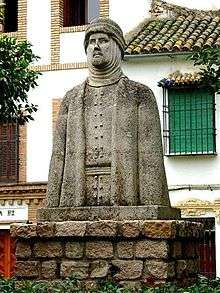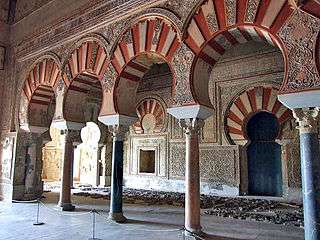Al-Hakam II
| Al-Hakam II | |
|---|---|
 | |
| 16th Caliph of Umayyad Dynasty 2nd Caliph of Córdoba | |
| Reign | 15 October 961– 16 October 976 |
| Predecessor | Abd-ar-Rahman III |
| Successor | Hisham II |
| Born | 13 January 915 |
| Died | 16 October 976 (aged 61) |
| Father | Abd-ar-Rahman III |
| Mother | Murjan |
Al-Hakam II (al-Ḥakam II ibn ʿAbd al-Raḥmān III; Arabic: الحكم الثاني ابن عبد الرحمن) (January 13, 915 – October 16, 976) was the second Caliph of Córdoba, in Al-Andalus and son of Abd-ar-Rahman III (al-Nasir) and Murjan. He ruled from 961 to 976.
Early rule
Al-Hakam II succeeded to the Caliphate after the death of his father Abd-ar-Rahman III in 961. He secured peace with the Catholic kingdoms of northern Iberia, and made use of the stability to develop agriculture through the construction of irrigation works. Economic development was also encouraged through the widening of streets and the building of markets.
Patron of knowledge
Hakam himself was very well versed in numerous sciences. He would have books purchased from Damascus, Baghdad, Constantinople, Cairo, Mecca, Medina, Kufa, and Basra. His status as a patron of knowledge brought him fame across the Muslim world to the point that even books written in Persia, which was under Abbasid control, were dedicated to him. During his reign, a massive translation effort was undertaken, and many books were translated from Latin and Greek into Arabic. He formed a joint committee of Muladi Muslims and Mozarab Catholics for this task.[1]
His personal library was of enormous proportions. Some accounts speak of him having more than 600,000 books. However, Hitchcock (2014: 91-92) argues that any number in excess of 600 is "inconceivable".[2] The catalogue of library books itself was claimed to be 44 volumes long. According to Hitchcock (ibid.), this may be because "volume" and "page" were confused. Of special importance to Al-Hakam was history, and he himself wrote a history of al-Andalus.[1] Following his death, Hajib Almanzor had all "ancient science" books destroyed.[3]
The mathematician Lubna of Córdoba was employed as Al-Hakam's private secretary. She was said to be "thoroughly versed in the exact sciences; her talents were equal to the solution of the most complex geometrical and algebraic problems".[4]
The famous physician, scientist, and surgeon Abu al-Qasim al-Zahrawi (Abulcasis) was also active in Al-Hakam's court during his reign.
Construction projects

His building works included an expansion of the main mosque of Córdoba (962–966), the Mezquita, and the completion of the royal residence Medina Azahara (976), which his father had begun in 936.
Military conflict in North Africa
Whilst the internal administration was left increasingly to the Berber vizir Al-Mushafi, general Ghalib was gradually gaining influence as leader of the army. He was chiefly preoccupied with repulsing the last Norman attacks (966, 971), and with the struggle against the Zirids and the Fatimids in northern Morocco. The Fatimids were defeated in Morocco in 974, while Al-Hakam II was able to maintain the supremacy of the caliphate over the Catholic states of Navarre, Castile and León.
Personal life
Al-Hakam married Subh of Cordoba, a Christian concubine. She held sway and strong influence over the court. It is said that al-Hakam nicknamed her with the masculine name Ja'far.[5] She bore him two sons, the first is Abd al-Rahman,[6] who died young, and the second is Hisham II.[7]
In his youth his loves seem to have been entirely homosexual.[8] He was known to have openly kept a male harem.[9] The fact that he did not produce a suitable heir before the age of 46 has been ascribed either to him being more attracted to men,[10] although this is only reported euphemistically in the sources,[6] or because he was too absorbed with his books to care for sensual pleasures.[5]
Different explanations have been given for Subh's choice of attire. While she may have dressed as a ghulam or a young man to attract al-Hakam (adopting a short haircut and wearing trousers with Al-Hakam supposedly giving her the male name of Ja'far), it is also possible she did it to gain better access to the male-dominated royal court.[11]
Death and succession
Al-Hakam II suffered a stroke near the end of his life that curtailed his activities and may explain why he was unable to properly prepare his son for leadership.[12] Modern scholars have speculated that, based on the historical descriptions of his death, it was another cerebrovascular stroke, possibly brought on by the cold weather, that claimed his life in October 976.[13] He was succeeded by his son, Hisham II al-Mu'ayad, who was 11 years old at the time and was a nominal ruler under Almanzor.
See also
References
- 1 2 Najeebabadi, Akbar (2001). The History of Islam V.3. Riyadh: Darussalam. p. 145. ISBN 978-9960-892-93-1.
- ↑ Hitchcock, Richard (2014). Muslim Spain reconsidered. Edinburgh: Edinburgh University Press. pp. 91–92. ISBN 978-0-7486-3960-1.
- ↑ Ann Christy, Christians in Al-Andalus:711-1000, (Curzon Press, 2002), 142.
- ↑ Scott, Samuel Parsons (1904). History of the Moorish Empire in Europe Vol. 3. Lippincott. p. 447.
- 1 2 Ruggles, D. Fairchild (2004). "Mothers of a hybrid dynasty: Race, genealogy, and acculturation in al-Andalus". Journal of Medieval and Early Modern Studies. 34 (1): 73.
- 1 2 Prado-Vilar, Francisco (1997). "Circular visions of fertility and punishment: caliphal ivory caskets from al-Andalus". Muqarnas. 14: 19–41. JSTOR 1523234.
- ↑ Christys, Ann Rosemary (2013-01-11). Christians in Al-Andalus 711-1000. Routledge. p. 106. ISBN 978-1-136-12730-4.
- ↑ Louis Crompton, Homosexuality and Civilisation, Harvard, 1990
- ↑ Homosexuality, Daniel Eisenberg, Encyclopedia of Medieval Iberia, ed. Michael Gerli (New York: Routledge, 2003), 398–399.
- ↑ Évariste Lévi-Provençal, Histoire de l'Espagne musulmane, Paris, 1950
- ↑ Ibtissam Bouachrine, Women and Islam, Lexington Books, 2014, pp. 5, 22
- ↑ Al-Hakam II, Caliph of Cordoba, Marilyn Higbee Walker, Encyclopedia of Medieval Iberia, ed. Michael Gerli (New York: Routledge, 2003), 377.
- ↑ Arjona-Castro, A. (February 1997). "Cerebrovascular stroke, the cause of the death of the caliph al-Hakam II". Neurologia. 12 (2): 78–81.
External links
| Wikisource has original works written by or about: Al-Hakam II |
| Wikimedia Commons has media related to Al-Hakam II. |
- Arabic biography
- Stirnet: Iberia04 (subscription required)
| Al-Hakam II Cadet branch of the Banu Quraish | ||
| Preceded by Abd-ar-Rahman III |
Caliph of Córdoba 961–976 |
Succeeded by Hisham II |
